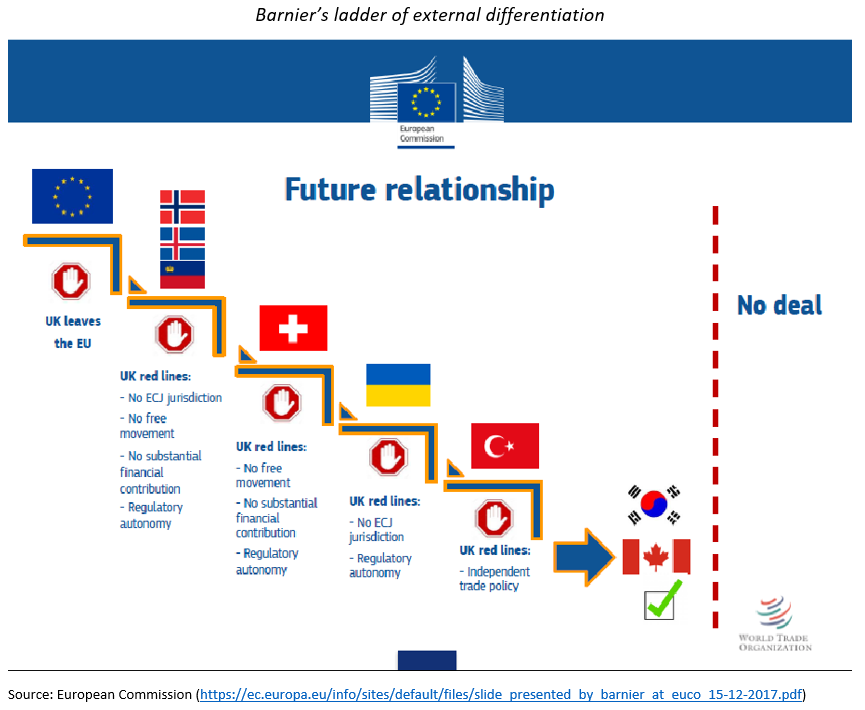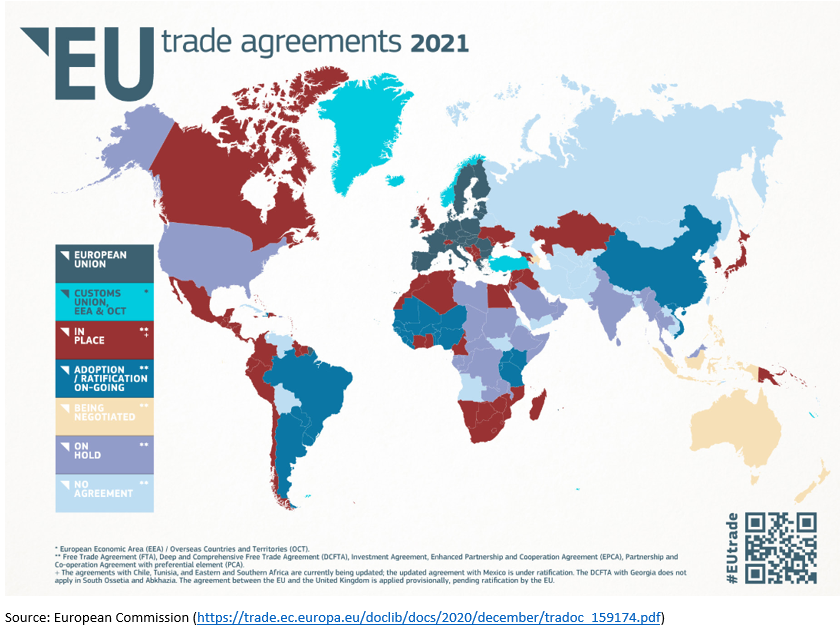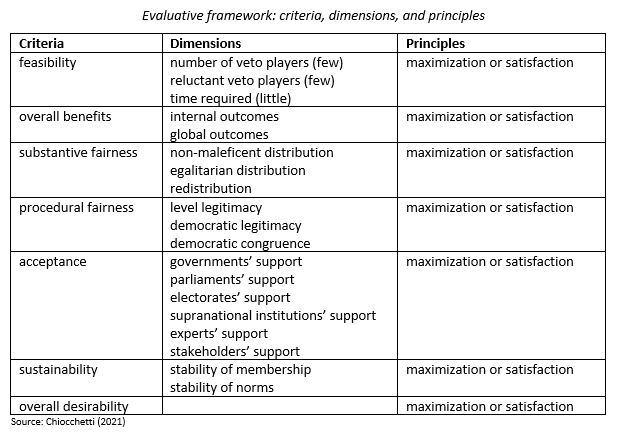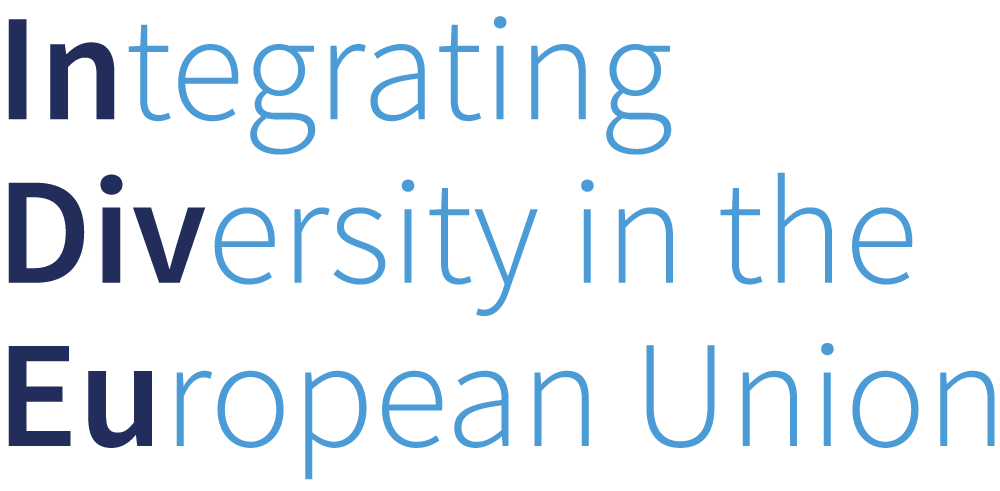External differentiated integration (external DI)is a form of European integration allowing for the selective extension of the validity of EU legal rules to non-members. External differentiated integration stands in opposition to both full (uniform or differentiated) integration through EU accession and differentiated disintegration entailing a more distant relationship. The fifth chapter of this manual summarizes the main features of external DI and offers evidence-based advice on how to choose and design effective schemes.
Forms
External differentiated integration entails an increasingly close external relationship between the EU and third countries, ensuring a growing legal alignment of the latter with EU norms while avoiding any granting of membership rights. As such, it can affect any aspect of the EU’s external relations with individual countries or groups of countries.
External differentiation comes in several forms, which do not however fundamentally alter its purpose and nature. First, differentiation can be achieved through the conclusion of international agreements between the EU and third countries (e.g. the 2020 EU-UK Trade and Cooperation Agreement) or be the result of the unilateral adoption of EU internal acts having an external effect (e.g. the 2016 General Data Protection Regulation). Second, it can affect the bilateral relationship with one individual country (e.g. the 1995 EU-Turkey Customs Union) or the multilateral one with a group of countries (e.g. the 1994 European Economic Area). Third, it typically destroys uniformity in the relation with third countries and creates instead a given number of discrete and ordered non-membership ‘steps’ on a continuous ‘integration ladder’. For instance, Schimmelfennig and Winzen have identified eight such ‘grades of non-membership’ (no institutionalized relationship, trade agreement, cooperation agreement, free trade area, bilateral agreement, association agreement, internal market integration, candidacy, and accession negotiations) while Michel Barnier has identified six ‘models of relationship’ (no deal, Canada, Turkey, Ukraine, Switzerland, and Norway). Fourth, each third country will inevitably take a place on such scale, exhibiting a closer (e.g. Norway) or more distant (e.g. North Korea) relationship with the EU. Fifth, external integration increases the sheer number of countries the EU has a relationship with in the first place. Sixth, external relations with specific countries can become closer over time, following a path of differentiated integration (e.g. pre-2013 Croatia), or more distant, following a path of differentiated disintegration (e.g. post-2020 United Kingdom). Finally, external differentiation typically gives third countries little substantive say in determining the content of applicable rules, beyond the initial negotiations on the scope of integration, some flexibility in the implementation, informal avenues of influence on EU institutions, and the threat to violate or withdraw from the treaty. Despite their formal nature of free contracts between equal parties under international law, many international agreements of the EU – particularly the most comprehensive ones, such as the EEA – essentially require the unilateral (static or dynamic) alignment of third countries with EU law, raising the danger of a ‘self-inflicted hegemony’. Theoretically, it might be possible to remedy to this problem by conferring partial membership rights to non-EU partners (e.g. reduced voting rights in relevant schemes and agencies), but such proposals are currently incompatible with primary EU law and unlikely to be ever accepted by the EU.


From a policy perspective, only two issues really matter. On the one hand, the EU is interested in the use of external differentiation as a tool to extend the validity and influence of EU norms and policies beyond its borders: as the number, closeness, and power asymmetries of its external relationships increase, so does the influence of the EU on the world stage. On the other hand, policymakers and practitioners are attracted to external differentiation as a viable alternative to EU enlargement, capable of reproducing most functional benefits of European integration while avoiding insurmountable political opposition to accession in existing member states and prospective candidate countries. Thus, highly developed external integration agreements have been concluded in the past with neighbours such as Iceland, Liechtenstein, Norway, Switzerland, Turkey, and the United Kingdom and are currently seriously discussed for candidate countries in the Western Balkans.
Patterns, causes, and outcomes
In terms of patterns, external differentiation is a constitutive feature of the external relations of the European Union, creating a complex web of differentiated relationshipsbetween the EU and third countries ranging from very weak to very strong levels of integration and legal alignment. International agreements of the EU include at least 2,183 treaties, covering virtually all sovereign countries of the world. Relationships achieving a substantial level of economic cooperation and legal integration (association, partnership, and trade agreements) have been established with roughly two-thirds of sovereign countries (around 125): they mainly encompass former European colonies and countries of the broader European neighbourhood, but also include cooperation and trade links with other Latin American, North American, and Asia partners. Preferential trade agreements exist with more than a third of countries (around 79); many of them provide for comprehensive free trade (e.g. the Trade and Cooperation Agreement with the United Kingdom). Finally, a handful of countries have achieved an extremely high level of market and policy integration with the EU: in particular, Turkey (customs union), Switzerland (bilateral agreements), Iceland, Liechtenstein, and Norway (European Economic Area), and four European microstates (de jure or de facto alignment). In addition, third countries are occasionally included without voting rights in policy-specific EU initiatives: for instance, seven of them participate in the Schengen Area (EU regime), four in the European Defence Agency (EU agency), and nine in the Energy Community Treaty (EU international agreement).

The external integration of third countries has tended to grow over time, with periodic pushes to establish closer relationships with former colonies in the Global South (e.g. Lomé Convention, Cotonou Agreement, and Economic Partnership Agreements), neighbouring countries (e.g. bilateral free trade agreements with EFTA members, European Economic Area, European Neighbourhood Policy), and important economic partners (e.g. recent free trade agreements with Canada and Japan). At the same time, differentiated integration frequently results in a successful accession bid (22 countries), transforming external partners in full EU members, and often encounters insurmountable obstacles in dealing with major powers (the United States, China, Russia, and India) and alternative economic blocs (Eurasian Customs Union, ASEAN, Mercosur). External agreements also tend to be formally very durable, with few cases of suspension, withdrawal, or termination. Finally, non-EU countries and societal actors are often led to align with EU norms even in absence of binding international commitments, particularly in order to gain access to the Single Market and other EU programmes (unilateral external DI, ‘Brussels effect’). This pressure has generally grown with the widening and deepening of European integration process but may be challenged in the future by the attractiveness of competing regional integration frameworks centred on China, the United States, and East Asian countries.
The causes of external differentiation are explained by Schimmelfennig and Winzen with a modified version of the model used for internal differentiation. The demand for differentiation is mainly shaped by heterogeneity (of preferences, dependence, and capacity) and country features (wealth, identity, capacity, and good governance). The supply for differentiation essentially depends on an asymmetric bargaining process, where negotiations are conducted between the EU as a bloc and the relevant third countries and typically require the unanimous consent of all member states involved (except for ‘EU-only’ agreements). As a result, affluent neighbours with a high governance quality and strong concerns about their national sovereignty (e.g. Switzerland) are more likely to refuse to join the EU and settle for lower levels of external integration, while poorer neighbours with a poor governance quality (e.g. Ukraine) may wish to pursue ever closer integration leading to EU accession but are more likely to be rejected by the EU. Beyond these factors, other aspects seem to play an important role in determining the degree of integration of third countries in the EU: in particular, a shared history with existing member states, geographical proximity, and geopolitical considerations.
Finally, external differentiated integration yields different outcomes compared to EU accession, the status quo, and differentiated disintegration. From a functional perspective, differentiated integration is preferrable when further integration would increase the overall net benefits of the relationship, but not in all policy areas and details. Theoretically, the scope and degree of external integration can be perfectly tailored to maximize such benefits; in practice, their content is strongly affected by distributive concerns (e.g. each party seeking to maximize its own benefits) and strategic considerations (e.g. the desire to encourage the potential EU accession of a country), increasing the likelihood of both a conclusion of suboptimal agreements and of a failure of negotiations. A precise quantification and comparative assessment of the costs and benefits of each option will inevitably depend on the specific details of each agreement: nevertheless, differentiated integration is often assumed to produce more overall benefits than status quo and less ones than EU membership. From a political perspective, external integration creates specific trade-offs between potential material gains, a loss of national autonomy, and a gain of influence on shared decision-making. Thus, some countries may wish to pursue a lower level of external integration to preserve their ability to freely determine their own laws and policies, at the cost of forfeiting important functional benefits, while other countries may want to pursue full EU membership to have a formal say in collective decision-making processes, at the cost of constraining their formal national autonomy. From a practical perspective, each type and degree of integration seems to be subject to a certain path dependence, as existing agreements are hard to terminate with legal means and likely to become less politically controversial over time. However, the commitments contained in international agreements are theoretically more exposed to the risks of obsolescence and non-compliance than those entrenched in EU law.
Scenarios
The possible impact of differentiation on the future course of European integration can be usefully explored with the help of scenarios: challenging, plausible, and memorable depictions of ‘possible futures’ which visualize their main expected outcomes and stimulate an informed debate about desirable visions, threats, opportunities, strategic choices, and appropriate institutional, legal, and policy solutions. To this end, the InDivEU project has developed Love thy neighbour 2035, a set of three analytical scenarios on external differentiation outlining the possible consequences of different strategic choices on the future of the European Union by 2035. The scenarios are based on an in-depth analysis of the relevant scientific literature and empirical evidence, presented in an analytical style, and depict three possible evolutions of the status quo (red dot): EU enlargement (Extended family), external integration (Close-knit community), and external disintegration (Good fences make good neighbours). While reflecting existing knowledge on the likely outcomes, strengths, weaknesses, and feasibility of each option, they leave each reader free to autonomously assess their desirability according to his or her own specific values, preferences, and sensibilities. The three scenarios can be read in the following policy paper.

Love thy neighbour 2035: three scenarios for external differentiation, Paolo Chiocchetti, Policy brief, EUI 2021
Recommendations
External differentiation can be assessed with the evaluation framework depicted in the figure below and already discussed in section 3.1.

The comparative desirability of more integrated external schemes (external integration) in relation to full integration with membership rights (EU accession), the existing level of integration (status quo), and less integrated external schemes (external disintegration) obviously depends on the specific features of the scheme, preferences of both parties (the EU and its member states on one side, the third country or countries on the other side), and broader international context. It therefore requires a case-by-case concrete analysis. Nevertheless, some general trendscan be derived from the available evidence and research.
The feasibility of external integration tends to be lower than the status quo but markedly higher than EU accession. The latter requires the satisfaction of restrictive accession criteria, complex negotiations, the unanimous consent of all governments involved, national ratification procedures involving additional veto players (but rarely supermajorities and referendums). In addition, it is usually more politically controversial, often leading to the emergence of resolute pockets of opposition within existing EU member states, candidate countries, and rival international powers.
The effectiveness of external integration is often higher than the status quo but lower than EU accession. Firstly, EU accession yields higher material benefits in all areas profiting from an increase in the scale of common policies (such as the promotion of exchanges or the provision of complementary goods) and is generally thought by experts to be on balance functionally preferrable for neighbouring and economically highly integrated countries. Secondly, the theoretical advantages of external integration, which allow both partners to tailor their relationship to exclude specific policy areas and sub-fields where uniformity is not actually beneficial, can rarely be realized in the course of the negotiations, as each party tries to maximize its own individual benefits (rather than overall ones). Finally, the same advantages can also be replicated by negotiating an EU accession with selective opt-outs and exceptions (internal DI). Thus, external integration tends to be functionally optimal only for countries with radically diverging identities, interests, and preferences in major policy areas or for the improvement of distant relations with weakly interdependent countries.
The substantive fairness of external integration is highly controversial, as it depends both on the unpredictable distributive effects of each agreement and on the divergent normative standpoint adopted by each country and independent observer to assess them. In general terms, the issue boils down to a trade-off between the costs and benefits of further integration, national policy autonomy, and shared influence on common decision-making. For third countries, rejecting accession offers the possibility to prevent adverse functional effects (e.g. sectoral economic shocks), limit contributions to the EU budget, and preserve the possibility to legislate in specific areas according to national preferences. On the other hand, it entails the potential for non-integration costs, negative externalities, and imposed or self-imposed domination, as the country will be forced to selectively align (statically or dynamically) with EU norms and case-law with little say over how those were formed and will evolve. For EU countries, rejecting enlargement offer the possibility to avoid the redistribution of ‘club goods’ with new countries (e.g. EU budget, single market, free movement) and preserve their existing influence of common decision-making. On the other hand, it also entails the potential for non-integration costs, negative externalities.
The procedural fairness of external integration is also highly controversial. Firstly, its geographical scope is often perceived as fairer than EU accession for relationships involving a weak sense of mutual solidarity and identification, but it may be strongly opposed on functionalist or cosmopolitan grounds as an obstacle to the solution of common problems with common means. Secondly, its democratic legitimacy tends to be both weaker (as it can encompass highly authoritarian countries) and more direct (as it ensures a stronger involvement of political institutions, i.e. governments and parliaments). Finally, it is equally problematic in terms of democratic congruence, as both forms of integration tend to ‘constitutionalize’ substantive commitments and make them less responsive to changing democratic preferences; however, such commitments are less intrusive and easier to circumvent in external integration.
Finally, the acceptance of external integration tends to be higher than full integration with membership. Accession is often rejected by the electorates of prosperous third countries (such as Norway, Switzerland, and the UK) while enlargement frequently elicits strong resistances among the electorates of existing member states, particularly if the candidate countries are poor, large, and perceived as distant (such as Turkey or Ukraine). The use of differentiation is generally very helpful in softening specific national oppositions and increasing the overall acceptance of agreements. Particularly close and intrusive external relationships, however, may remain highly controversial and be the object of national vetoes or pressures for renegotiation: for example, the comprehensive trade and partnership agreements with Switzerland, the United Kingdom, or Canada.
Altogether, some general recommendations can be formulated with regard to the choice and design of external differentiation schemes. First, external integration should be considered in situations characterized by the following features: a selective but strong heterogeneity in preferences, dependencies, and capacities; generally positive overall benefits of further integration with major sector-specific problems; a weak sense of shared identity and solidarity; and serious practical or political obstacles to EU accession. EU accession – if necessary, with transitory exceptions, selected opt-outs, and compensatory mechanisms – should be preferred for countries with strong geographical and economic ties, a shared identity, and similar preferences to EU member states; external disintegration may be a better solution for countries with fundamentally different interests and identities. Secondly, the status quo is often the most feasible and accepted choice, but external integration tends to be markedly superior to EU accession in both respects. Thirdly, the design of external integration schemes should respect vital interests and preferences of both parties, focus on the areas of cooperation most likely to yield large mutual benefits, avoid an excessively one-sided distribution of benefits, include effective (formal or informal) consultation and participation mechanisms of both parties in the formulation of new norms bound to affect them, and refrain from excessively compressing existing levels of democratic accountability and congruence (e.g. transparent public debates and parliamentary ratifications, reasonable avenues to renegotiate mutual commitments, no support for autocratization).
